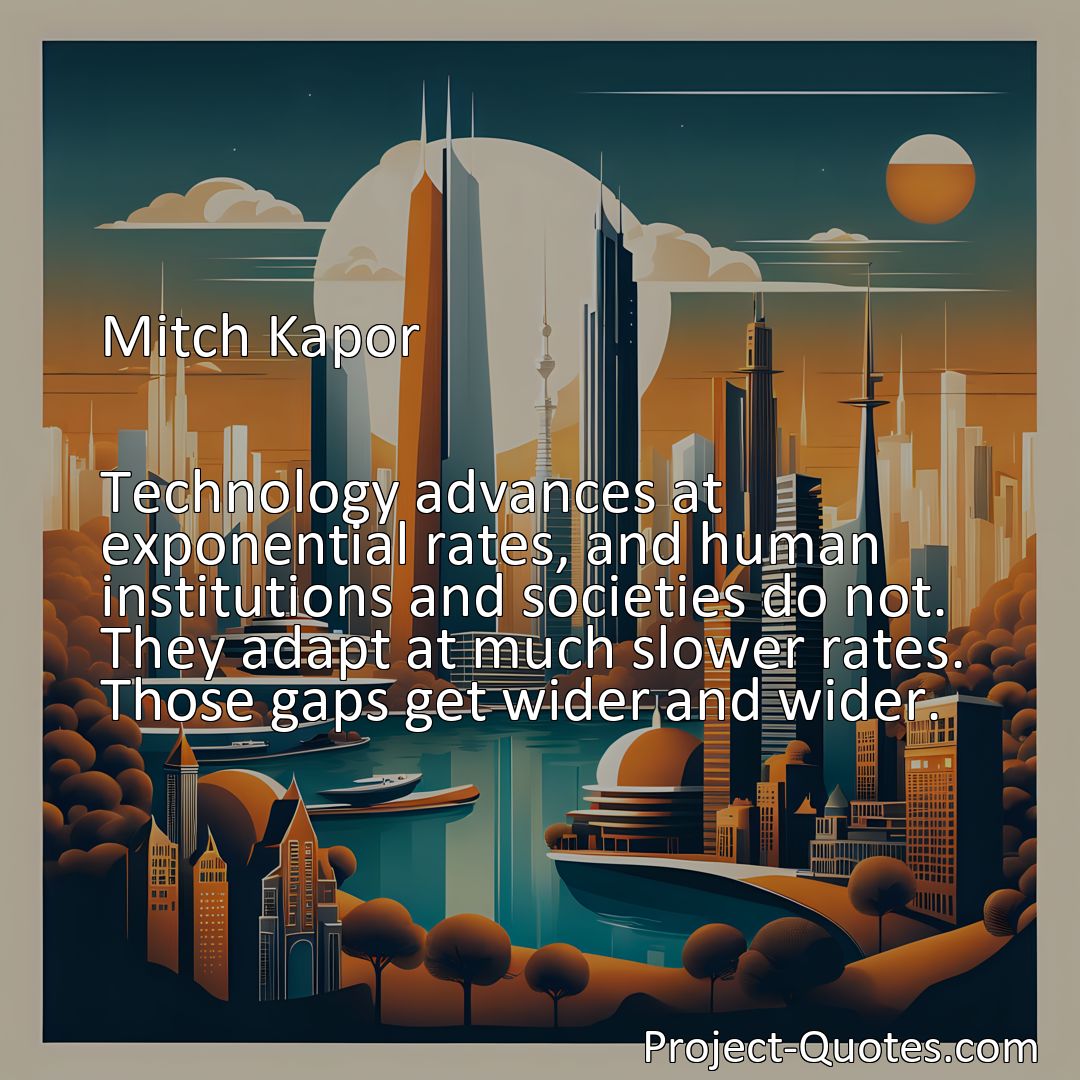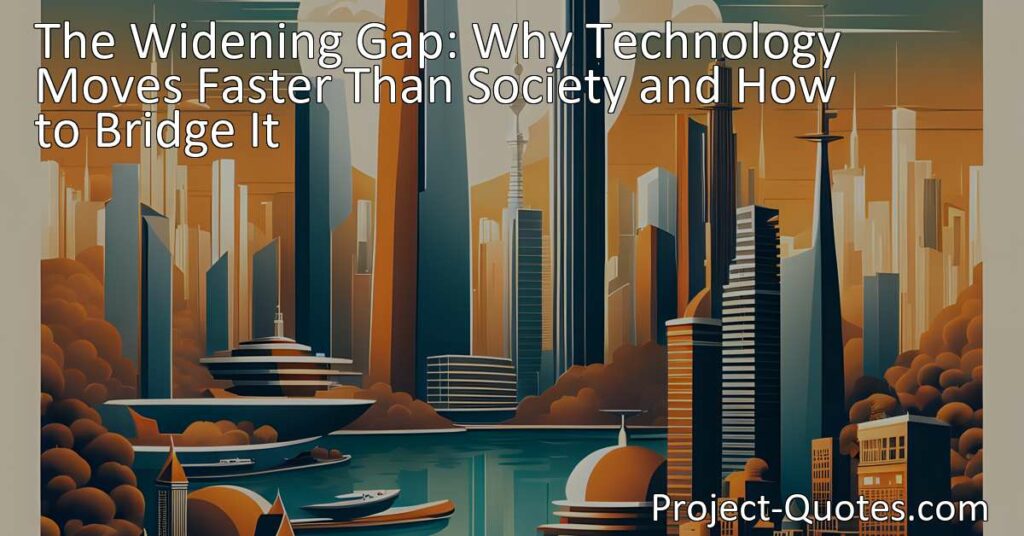Technology advances at exponential rates, and human institutions and societies do not. They adapt at much slower rates. Those gaps get wider and wider.
Mitch Kapor
The Widening Gap: Why Technology Moves Faster Than Society and How to Bridge It Have you ever wondered why it often feels like technology is moving faster than the rest of the world? Technology advances at exponential rates, leaving human institutions and societies struggling to keep up. This growing gap between technology and our ability to adapt has far-reaching implications, from the way we communicate and work to the social and economic structures we rely on. However, by integrating technological literacy into education, keeping pace with regulation, fostering a culture of lifelong learning, and addressing the digital divide, we can bridge this gap and harness the opportunities presented by technological innovation.
Table of Contents
- 1 Technology advances at exponential rates, and human institutions and societies do not. They adapt at much slower rates. Those gaps get wider and wider.
- 2 Mitch Kapor
- 3 Meaning of Quote – Technology advances at exponential rates, and human institutions and societies do not. They adapt at much slower rates. Those gaps get wider and wider.
- 4 Freely Shareable Quote Image
- 5 Related
Meaning of Quote – Technology advances at exponential rates, and human institutions and societies do not. They adapt at much slower rates. Those gaps get wider and wider.
Have you ever wondered why it often feels like technology is moving faster than the rest of the world? It’s because technology advances at exponential rates, leaving human institutions and societies struggling to keep up. This growing gap between technology and our ability to adapt has far-reaching implications, from the way we communicate and work to the social and economic structures we rely on.
At its core, the rapid advancement of technology stems from the power of human innovation and our relentless pursuit of progress. From the invention of the wheel to the development of artificial intelligence, each breakthrough builds upon the previous one, accelerating the rate of change. In contrast, human institutions and societies are built upon complex systems that have evolved over centuries. These systems, be it governance, education, or social norms, are deeply ingrained in our culture and are often resistant to change.
Let’s consider some examples that illustrate the wide gap between technology and human adaptation. Take smartphones, for instance. Just a few decades ago, these devices were unheard of, and now they are an integral part of our lives. We use them to connect with others, access information, and even manage our daily tasks. However, our laws and regulations pertaining to privacy, cybersecurity, and digital rights struggle to keep up with the rapid advancements in smartphone technology. As a result, we often find ourselves in a constant game of catch-up, trying to address new challenges that arise as technology outpaces our ability to regulate it effectively.
Another area where the gap between technology and adaptation is increasingly evident is in the realm of work and employment. Automation and artificial intelligence are transforming the job market, leading to questions about the future of work. While technology continues to create new opportunities and industries, the skills required to thrive are constantly changing. This poses a significant challenge for our education systems, which are often slow to adapt their curricula to equip students with the necessary skills for the modern workforce. As a society, we must grapple with how to ensure that our workforce remains relevant and prepared for the jobs of tomorrow.
Moreover, the widening gap between technology and human institutions also profoundly impacts social and economic structures. Take the rise of social media, for example. Platforms like Facebook, Instagram, and Twitter have revolutionized the way we communicate and share information. However, these technologies have also given rise to new challenges, such as the spread of misinformation, cyberbullying, and issues surrounding data privacy. Our legal frameworks struggle to keep pace with these challenges, and developing effective regulations to address them becomes increasingly difficult. As a result, we find ourselves in a constant tug-of-war, trying to find a balance between the benefits of technology and the potential harm it can cause.
Furthermore, the wider gap between technology and human institutions also raises concerns about societal inequalities. Access to technology and digital literacy are not evenly distributed, creating what is commonly known as the “digital divide.” This divide exacerbates existing social and economic disparities, as those without access to technology are further marginalized. Bridging this divide requires proactive efforts to ensure that everyone has equal opportunities to benefit from technological advancements. It also demands investment in digital literacy programs to empower individuals with the skills and knowledge necessary to navigate the digital landscape.
While the widening gap between technology and human institutions presents significant challenges, it also offers opportunities for growth and development. Embracing technological innovation and adapting our institutions to its rapid pace can lead to transformative changes in various aspects of our lives. However, addressing this gap requires a multi-faceted approach.
Firstly, we need to recognize the importance of integrating technological literacy into our education systems from an early age. By equipping students with digital skills and critical thinking abilities, we can empower them to navigate the ever-evolving technological landscape effectively. This includes teaching them about online safety, digital citizenship, and ethical considerations related to technology.
Secondly, policymakers and regulators must work diligently to keep pace with technological advancements. This entails regularly reviewing and updating legal frameworks to address emerging challenges effectively. Collaboration between governments, industry leaders, and civil society is crucial to strike the right balance between innovation and the protection of individuals’ rights and interests.
Additionally, fostering a culture of lifelong learning is essential. As technology continues to advance at an exponential rate, staying updated and adaptable becomes increasingly important. Encouraging individuals to engage in continuous learning and professional development ensures that they can thrive in an ever-changing world.
Lastly, it is crucial to address the digital divide and ensure equal access to technology and digital literacy for all. This requires investment in infrastructure and connectivity, coupled with initiatives aimed at increasing digital literacy among marginalized communities. Bridging this divide will not only reduce inequality but also unlock the untapped potential of individuals who are currently left behind due to lack of access.
In conclusion, technology’s exponential rate of advancement compared to the slower rate at which human institutions and societies adapt creates a widening gap between the two. This disparity has significant implications for various aspects of our lives, from the way we work and communicate to social and economic structures. However, through proactive measures such as integrating technological literacy into education, keeping pace with regulation, fostering a culture of lifelong learning, and addressing the digital divide, we can bridge this gap and harness the opportunities presented by technological innovation. It is essential to navigate this ever-changing landscape effectively and ensure that technology remains a force for societal progress and equality.
I hope this quote inspired image brings you hope and peace. Share it with someone who needs it today!


